Top 14 of the World's Rarest Flowers
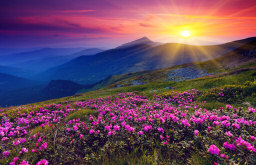 The workings of nature are truly a thing of wonder. Nothing quite compares to
the beauty of the world in its unmolested and unrefined state. From every corner
of the globe, strange and beautiful flowers have emerged to take center stage in
the work of botanists and horticulturists alike. These exotic offerings cover
all types of flora imaginable, providing a glimpse into just how unique the
various paths of evolution can be. For even the most seasoned scientist or
researcher, reviewing these rare and intriguing offerings is far from ordinary.
The following rare flowers are sure to pique your interest and cause you to
reevaluate just how much you think you know about the quirks and oddities of the
natural world. The workings of nature are truly a thing of wonder. Nothing quite compares to
the beauty of the world in its unmolested and unrefined state. From every corner
of the globe, strange and beautiful flowers have emerged to take center stage in
the work of botanists and horticulturists alike. These exotic offerings cover
all types of flora imaginable, providing a glimpse into just how unique the
various paths of evolution can be. For even the most seasoned scientist or
researcher, reviewing these rare and intriguing offerings is far from ordinary.
The following rare flowers are sure to pique your interest and cause you to
reevaluate just how much you think you know about the quirks and oddities of the
natural world.
14) Jade Vine
(Strongylodon macrobotrys)
Located exclusively in the Philippines, the Jade Vine, otherwise known as
Strongylodon macrobotrys, is a beautiful and rare specimen. The physical
characteristics of this plant can be described as delicate and fascinating. The
woody vine is covered in claw shaped flowers, giving it a unique look. These
claw-like outcroppings sprout from hanging trusses and can grow up to three
meters in length. The coloring of the flowers varies between a shade of mint
green and a blue green tint.
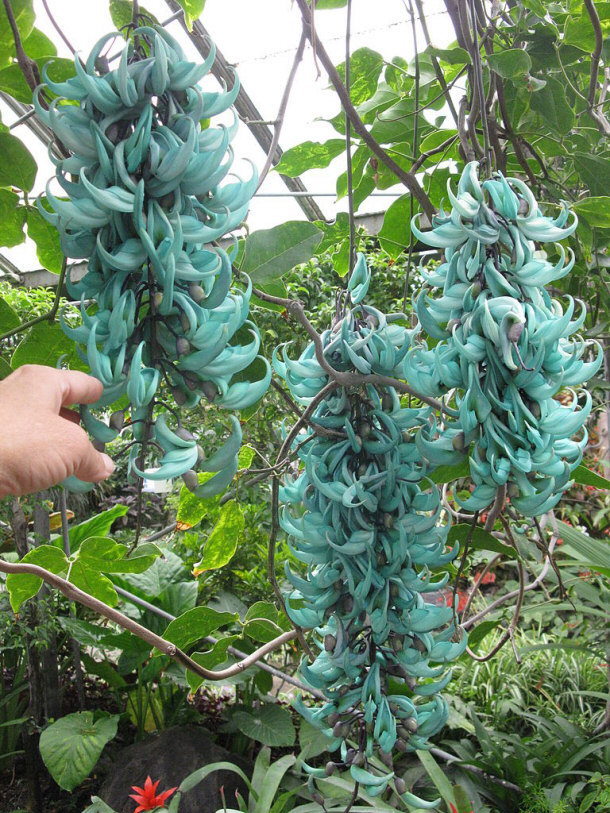
By Torontofiredancer,
via Wikimedia Commons
Due to the deforestation of its natural habitat, as part of the expansion of
the Filipino people, as well as a shifting climate, the Jade Vine has rapidly
dwindled in numbers and lost a significant portion of the population's
pollinators. This lack of viability and struggle to propagate has led the vine
to be considered an endangered species. While the long term outlook for the
plant is grim, supporters and environmentalists alike are working hard to find
new methods and compromises with the expanding population that will keep this
species alive long into the future. Without such collaborative efforts, the Jade
Vine will certainly face the prospect of extinction.
13) Campion
(Silene tomentosa)
The next flower on the list actually almost didn't make it at all. The
Campion, or Silene tomentosa, was initially considered to be an extinct species
of flower by the scientific community in 1992. However, this was not quite the
case. In 1994 a most fortuitous event occurred for Campion enthusiasts around
the world. A hiker, working through the rugged and imposing cliffs of Gibraltar,
stumbled upon a single Campion specimen. From here, the fate of one of the
rarest flowers ever was drastically altered. Below is an image of the Red
Campion in the wild.
Red Campion:
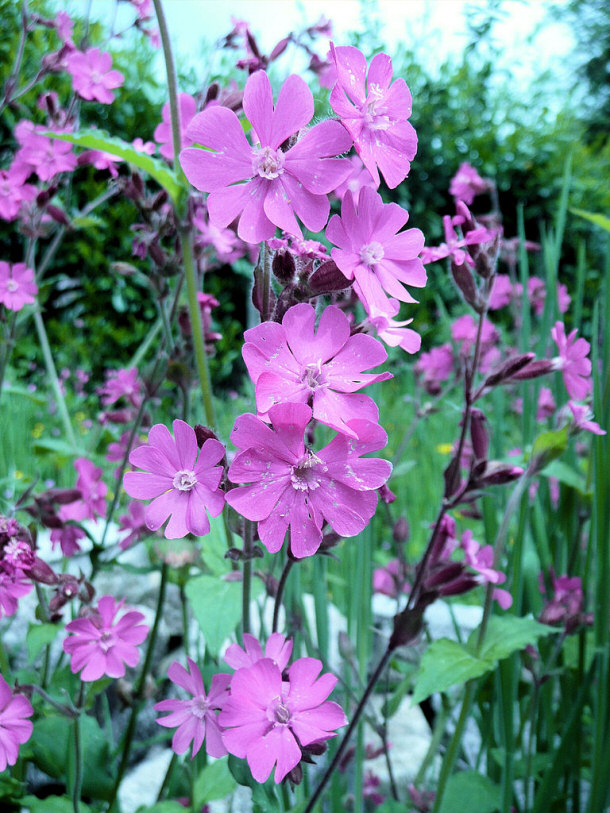
By Romfordian,
via Wikimedia Commons
Scientists proceeded to nurture the Campion back to health and viability.
Beginning with the Millennium Seed Bank in West Sussex, England, the propagation
of this rare species began with great fervor. From here, samples and colonies
were grown at the Almeda Gibraltar Botanic Gardens and the Royal Botanic Gardens
in London. With some dedicated effort, this species that was once presumed
extinct now has a shot at returning to a stable and sustainable position among
its contemporaries.
In regards to the characteristics of the plant, the Campion is a beautiful
lavender flower with multiple double petal outgrowths. The natural habitat of
the plant is exclusively found on the cliffs of Gibraltar, allowing for only the
most adventurous of outdoor enthusiasts to view the plant in its natural
habitat. It is here that the plant can be found hanging from the cliffs of the
mountainous areas of this British Overseas Territory.
12) Yellow and Purple Lady Slippers
(Cypripedium calceolus)
As far as unique and rare offerings go, few flowers can match the Yellow and
Purple Lady Slippers, also known as Cypripedium calceolus. This member of the
orchid family has an odd and intriguing history attached to it. Initially Yellow
and Purple Lady Slippers were found across almost all of Europe and the United
Kingdom as well. However, shifts in populations, changes in the environment, and
a weak approach to adaptation in general forced this flower to the brink of
extinction.
Today, Yellow and Purple Lady Slippers are located in only one area of the
world – a single golf course in the Untied Kingdom. The location of this golf
course is a closely guarded secret by scientists, although an information leak
has exposed that it is somewhere in the Lancashire, England. In fact, this rare
orchid species is so valued that is has officially been under police protection
for almost 100 years. Few flowers can lay claim to such a unique set of
circumstances.
Outside of the unusual story that follows the remaining Yellow and Purple
Lady Slippers, this orchid is also known for its beauty. Combining a bivalved
leafy growth, both purple and yellow sections are on display. Like most orchids,
the flower exudes a delicate leaf structure and a stalk appendage which serves
as the base of the plant. Below is a yellow lady slipper:
Yellow Lady Slipper:
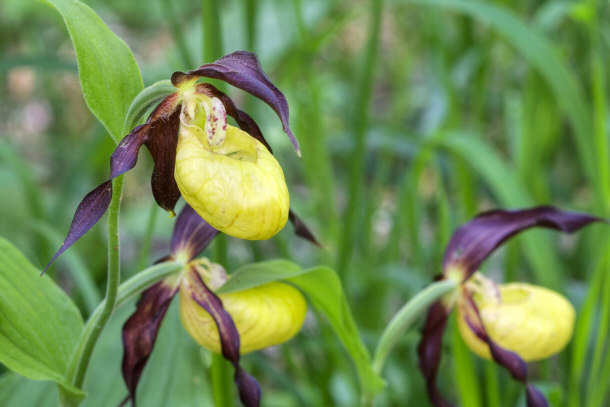
Such beauty serves as a strong factor in the push for
protection for the Yellow and Purple Lady Slippers population.
11) Corpse Flower
(Amorphophalus titanum)
The Corpse Flower is an oddity, even among its rare flower brethren. This plant is found only in
low lying rainforests that are scattered across the various islands of
Indonesia. What makes this plant so intriguing is that its survival is based off
of the existence of another species of plant altogether. Without the Tetrastigma
Vine, the Corpse Flower would have been pushed out of existence long ago.
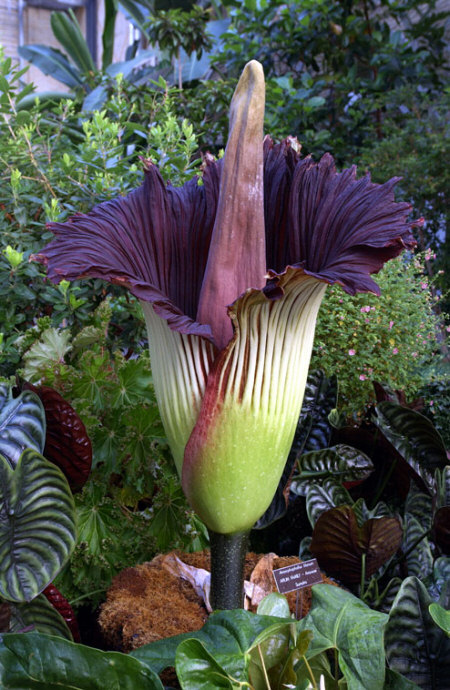
By US Botanic Garden
via Wikimedia Commons
Because this flower is a rootless, leafless, bodiless, and stemless parasite,
it gains all of its nutrition from the Tetrastigma Vine. This dependency may
seem odd at first glance, but it is also found in other evolutionary tracts
across the globe. Adding to the intrigue of this story is the fact that the
Corpse Flower is also a carrion plant – which seems appropriate, given its name.
As a carrion plant, this flower exudes a unique smell that is similar to the
stench of rotten flesh and meat. This mechanism attracts beetles and other bugs
which aid the Corpse Flower in the pollination process by spreading essential
components to other areas.
When reviewing the physical aspects of the Corpse Flower, remember that
beauty is most certainly in the eye of the beholder. This specimen has several
flap-like, fleshy red leaves and a bulbous, open core in the middle. When in
bloom, this core releases the foul, rotten smell mentioned above. The blooming
process only lasts for a week. After this process is finished, the flower
abruptly dies.
10) Kadupul Flower
(Epiphyllum oxypetalum)
While the Kadupul Flower, otherwise referred to as Epiphyllum oxypetalum, is
not on the brink of extinction, it is rare for an entirely different reason.
This flower can be found only in the forests of Sri Lanka and blooms only during
the nighttime hours. This blooming is exceedingly rare and is properly viewed
only under the most specific of circumstances. Once the blooming process is
complete, the flower withers before the approach of dawn. Why this process
occurs is unknown to botanists.
The beauty of the blooming Kadupul Flower is unmatched in the eyes of many.
With long, thin white petals and a delicate yellow core, many individuals
cherish the opportunity to view this rare process that occurs only in the dead
of night. On the spiritual side, this flower also holds a unique significance to
those of the Buddhist tradition. Take a quick look below:
Kadupul Flower:
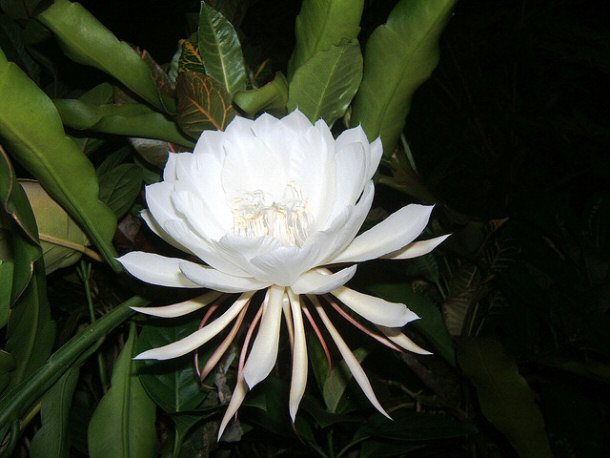
According to the practitioners of this faith, the Kadupul Flower blooms to
signify the descent of the Nagas - a Buddhist practicing early human culture.
Its believed that the flower
is a gift to Buddha from the tribe to signify their appreciation of his
teachings and works. In Japan, the flower is also revered and referred to as the
"Beauty under the Moon."
9)
Attenborough's Pitcher Plant (Nepenthes Attenboroughii)
Another rare flower that hails from the Philippines, the Attenborough's Pitcher
Plant has an intriguing history attached to its name. After a two-month
expeditionary trip into the heart of the jungle on several islands, Stewart R.
McPherson, Volker B. Heinrich, and Alastiar S. Robinson discovered this plant.
This discovery was considered an amazing success, as the point of the expedition
was to catalog the various indigenous pitcher plants of the Philippines, of
which the Nepenthese attenboroughii now claims membership.
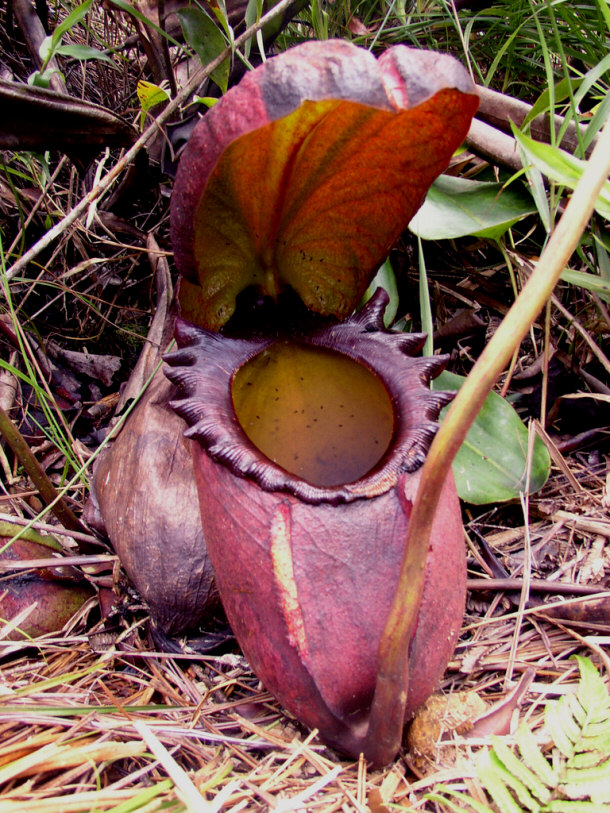
The plant was named after British broadcaster and naturalist Sir David
Attenborough. Because of his affinity for the various members of the pitcher
plant genus, the homage is definitely appropriate. Like most other pitcher
plants, the Nepenthes attenboroughii has a large gourd which is used to lure in
insects and other small prey. From here, the carnivorous plant traps and digests
the unsuspecting victims in an efficient manner. A unique attribute to this rare
plant is the size of its gourd. Considering that it can grow up to 1.5. meters
in length, the Nepenthes attenboroughii is one of the largest members of its
genus.
The Nepenthes With a Tree Frog Awaiting Prey:
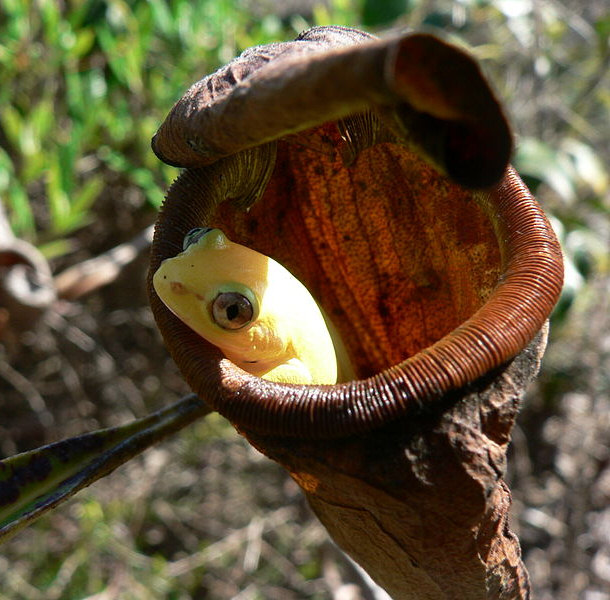
By Katja Rembold,
via Wikimedia Commons
8) Parrot's Beak
(Lotus berthelotii)
The Lotus berthelotii, or Parrot's Beak, is one of the more stunning
additions to this list. With a long stalk that has several flowers attached to
it, few plants showcase the beauty of this offering. Each flower resembles the
curvature of a parrot's beak, giving the flower its unique name. The coloring of
the petals is often a dark orange, with tints of red at the tips and yellow at
the base.
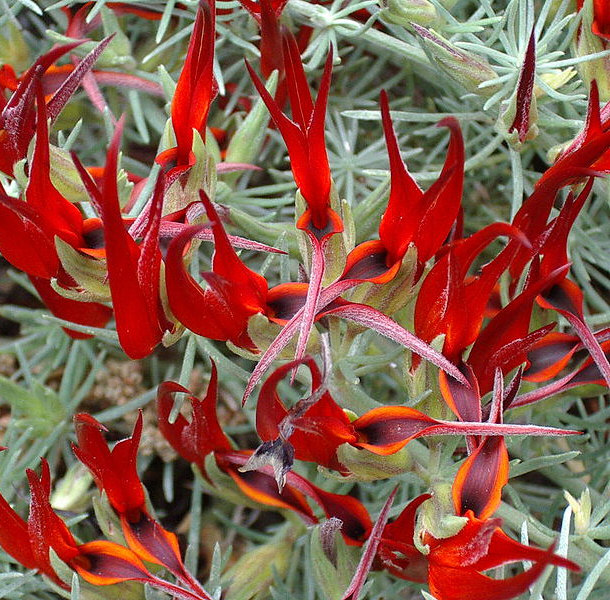
By Juanillo1976,
via Wikimedia Commons
As for history, the Parrot's Beak has plenty. Originally, this plant was
located only in the Canary Islands. However, it is now unknown if this plant is
currently alive in the wild. While many specimens are kept in captivity,
including those for sale to you and other plant enthusiasts, the loss of the
entire sunbird population in the Parrot Beak's native home has led to an almost
complete destruction of wild populations of the flower.
Scientists have sought to find a similar aviary species to cover the roles of
the sunbird in the pollination process of the Parrot's Beak. However, no known
substitute has been found. Thankfully, artificial pollination has kept this
beautiful and rare flower from facing complete annihilation.
7) Koki'o
(Kokai cookei)
Coming from the beautiful islands of Hawaii, the Koki'o (Kokai cookei) is an
exceedingly rare blossoming tree. Originally, the tree was discovered in 1860.
At that point in time, scientists believed that only three specimens of the
plant existed in the wild. With this knowledge, efforts were made to bring the
plant to botanic gardens to help avoid an extinction event. However, they felt
they had failed when the last seedlings died in 1950.
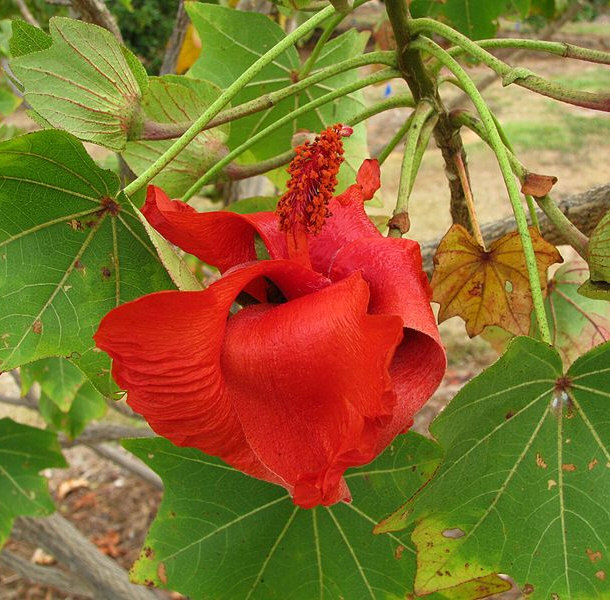
By David Eickhoff from Pearl City, Hawaii, USA,
via Wikimedia Commons
Thankfully, a single remaining Koki'o was found in 1978. However, the story
continues to unfold in dramatic fashion with this specimen being destroyed in a
fire in 1978. Miraculously a branch somehow escaped the flames and led to the
creation of 23 other trees. With this population, the continued existence of the
Koki'o is in much better shape.
The Koki'o is revered for its beautiful blossoms. Annually, each tree
produces several hundred glorious red blossoms. These curved flowers produce a
red stalk that matches the vibrant shades of the petals. In total, the tree can
grow up to 11 meters in height. Consider yourself lucky if you are fortunate
enough to catch a glimpse of one of these beautiful and rare trees in the midst
of blossoming.
6) Ghost Orchid
(Dendrophylax lindenii)
Of all the rare plants listed the Ghost Orchid or Dendrophylax lindenii, may
be the oddest addition to this list. With an inability to complete the photosynthesis
process, and severe issues with propagation methods, it is amazing that this
plant is still in existence. In fact, since its discovery there have been
several periods where the Ghost Orchid was presumed to be extinct. However, the
plant has a way of barely hanging and living another day.
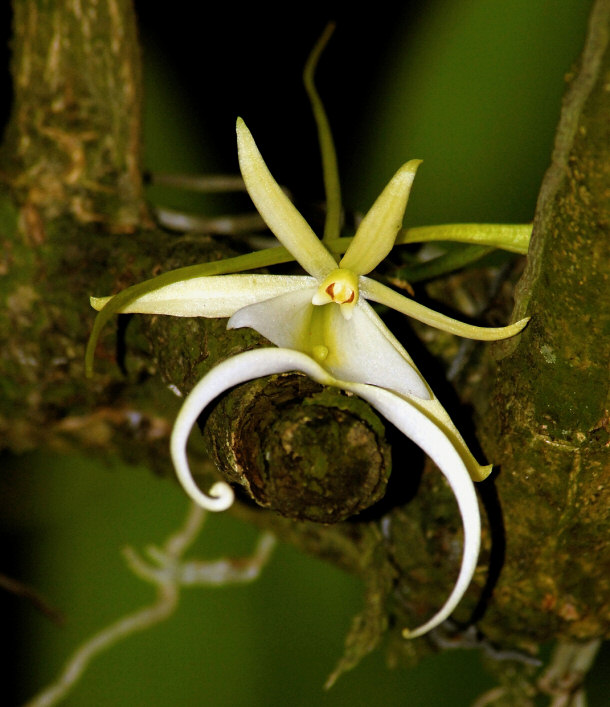
The Ghost Orchid requires a specific type of fungus to provide it with
sustenance. Because of this relationship, the plant is only found in certain
areas of Florida and Cuba. Found both underground and on cypress trees, the
strange texture and eerie look of the plant provide ample reason for the
haunting name. The flower's blooming season occurs between June and August.
During this time, the Ghost Orchid emits fragrant scents. These scents are used
to attract Giant Sphinx Moths – the only known pollinators of this plant.
Ghost Orchids in the Wild:
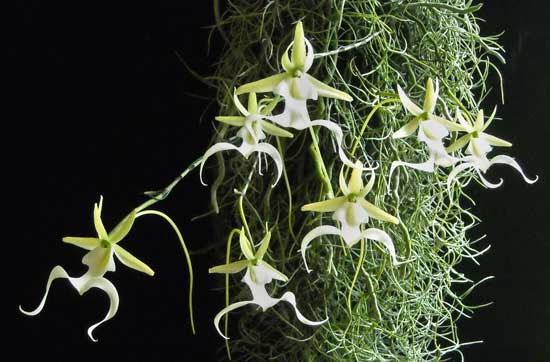
By Jeffalanhale
via Wikimedia Commons
As for physical characteristics, the Ghost Orchid contains long flowing white
leaf-like appendages that sit atop delicate stalks. These stalks are vital for
latching on to nearby cypress trees, thus keeping the orchid off of the ground.
When contracted and dormant, the Ghost Orchid can live underground for extended
periods of time.
5) Chocolate Cosmos
(Cosmos atrosanguineus)
Also referred to as the Cosmos atrosanguineus, the Chocolate Cosmos is an
interesting and rare flower. This offering is no longer found in the natural
world. Once, the plant was indigenous to many areas in Mexico. However, wild
variations of the flower went extinct at the turn of the 20th century.
Thankfully, the Chocolate Cosmos was preserved in captivity and saved from
joining a long line of extinct flowers.
In captivity, the Chocolate Cosmos is cloned by way of vegetative
propagation. The first successful attempt at this process occurred in 1902. From
this point on, the species has been protected by the qualified and caring hands
of many botanists. Without their hard work, the world would sorely miss this
beautiful and rare flower. Below is an image of this rare, but beautiful
flower:
Chocolate Cosmos:
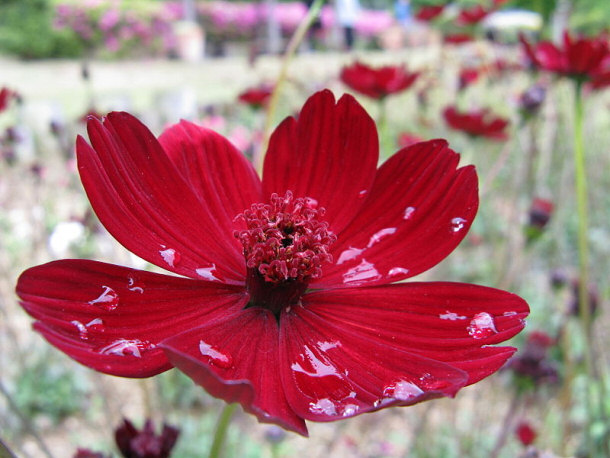
By KENPEI,
via Wikimedia Commons
The flowering leaves of the Chocolate Cosmos is a deep, dark red and maroon
combination. The rings of petals can range from six to ten rows. During
pollination periods, the flower emits a decadent scent that many have described
as having elements of vanilla and cocoa beans. With such a sweet scent, the
debate of naming the Chocolate Cosmos was surely a quick affair.
4) Franklin Tree
(Franklinia alatamaha)
As a member of the tea family the Franklin Tree has a unique and interesting
history. The Franklinia alatamaha is the only known member of its genus. Few
other plants can lay claim to such a distinction. Additionally, this flowering
tree was only found in the Altamaha River Valley in the state of Georgia.
Unfortunately, this rare and beautiful species is no longer found under natural
circumstances. The only remaining specimens are found in various botanical
gardens and reserves.
So what kept the Franklin Tree from entering the history books as an extinct
species? One family can be thanked for their hard work and dedication to the
preservation efforts of this plant. The Bartram family, a group of avid
horticulturists, saved samples of the tree and artificially pollinated several
specimens to ensure its survival. The lineage of the remaining trees all trace
their roots to these protected samples. Without this foresight and successful
work, the fate of the Franklin Tree would have been grim indeed.
As for physical beauty, few trees rival what the Franklin Tree has to offer.
With long, pear-shaped green leaves, the tree has a distinct look that draws on
its tea tree heritage. When in bloom, the plant grows large white bulbs. Upon
the completion of the blossoming phase, these white bulbs open into rows of
large white leaves which expose an attractive yellow core. This middle portion
and its fragrant scent is used to entice various insects to the flower for
pollination.
Franklin Tree in Bloom:
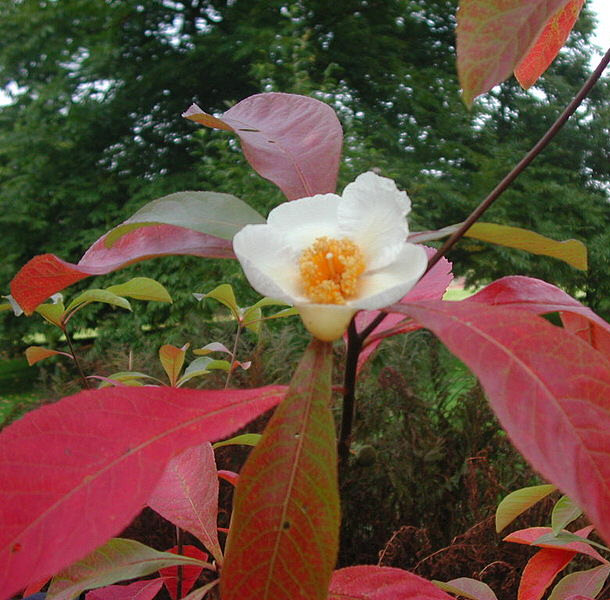
By Francine Riez,
via Wikimedia Commons
3) Snowdonia Hawkweed
(Hieracium snowdoniense)
|
Snowdonia Hawkeed Plant:
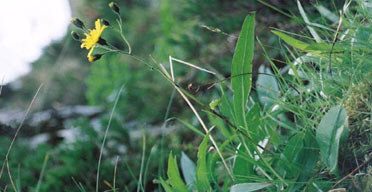
|
Anything with the word "weed" in its name should be fairly common, right?
Well that is not exactly true when discussing the Snowdonia Hawkweed. This
simple flower is relegated to existing in only one place on Earth. If you are
ever traveling in the Welsh valley of Snowdonia, you may be lucky enough to come
across this enigmatic plant if you keep a keen eye on your surroundings. The
number of patches of the Snowdonia Hawkweed has fallen to as low as seven
patches in this valley during the 20th and 21st centuries.
Initially, botanists claimed that the flower was extinct in the 1950s. For
the next 52 years, this claim was assumed to be accurate. However, 2002 saw the
plant rise again into the collective conscious of rare plant enthusiasts
worldwide. From this point, extensive measures have been taken to ensure the
continued survival of this incredibly rare flower. Conservation protocols and
restrictions have helped preserve portions of the valley, all in an effort to
promote the re-population of this plant.
Snowdonia Hawkweed Flowers Up Close:
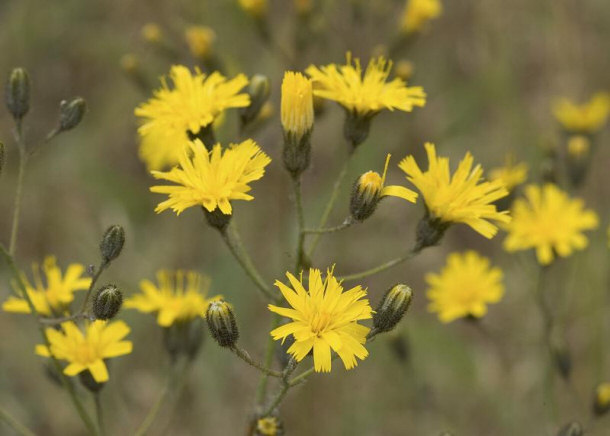
When the Snowdonia Hawkweed blooms, it maintains characteristics of other
weeds with which you may be familiar. Long light green sprouts end in dark green
tones and a black bulb. When this bulb opens, simple yellow flowers ring a
center section of pollen. Although this plant may look like your average garden
weed, plucking it in the wild could have disastrous consequences.
2) Black Bat Flower
(Tacca
chantrieri)
With a name like the Black Bat Flower, it is safe to assume that the Tacca
chantrieri is a unique species. Found only in the tropical forests of southern
and central China, specifically in the Yunnan Province, the population of the
Black Bat Flower can vary drastically. Although some offerings are currently
available from commercial outlets, wild specimens of this plant have become
increasingly rare due to the expansion and deforestation of the area. Without
the proper precautions and conservation efforts, the wild population of Black
Bat Flowers could face the threat of extinction. Look at the image below
and look at its complexity.
Black Bat Flower:
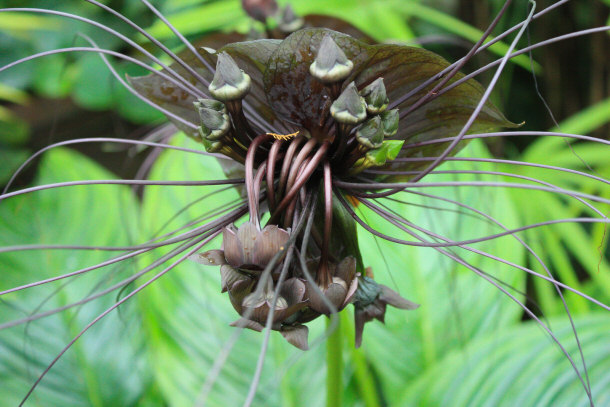
The flower takes on a very unique look. Atop a long stalk, which can grow up
to a full meter in height, resides a flowering appendage. These flower petals
take on a dark purple or black coloring, giving way to the naming conventions
associated with the plant. From here, the blooms of the Black Bat Flower sprout
"whiskers." these whiskers are long, thin strands that can grow to copious
lengths and hang the full length of the stalk, touching the jungle floor.
If you are considering purchasing a Black Bat Flower that has been
commercially grown and pollinated, keep in mind a few crucial requirements for a
successful growth. Otherwise, you may find that your expensive and beautiful
plant does not agree with its new habitat. This species prefers a tropical
and humid environment. Additionally, light shade and moist soil are also
agreeable to the Black Bat Flower.
1) Middlemist Red
(Middlemist camellia)
Few flowers can compare to the rarity of the Middlemist Red or Middlemist's Red. Also known as
the Middlemist camellia, this flower was once indigenous to several regions in
China. However, time and the expansion of the industrial world have altered this
plant to the point of a severe decline in its population. How severe is this
decline? Only two are left in the entire world. Below is an image of this
extremely rare flower.
Middlemist or Middlemist's Red:
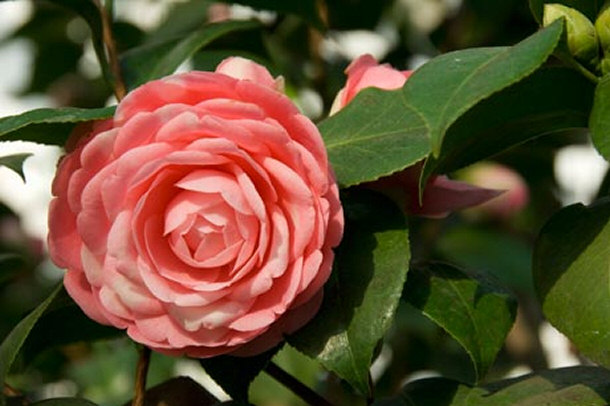
Over 200 years ago, John Middlemist brought back a specimen from China to the
United Kingdom. Today, the distant relatives of that Middlemist Reds live on in
the Chadwick House in West London. The other sample of this rare plant is found
in New Zealand. With only two plants left, much is being done to preserve and
protect these flowers from a future in which no samples remain.
The dedication of these scientists and botanists is well worth the effort.
With soft, circular petals and a gentle tint of pink and red, the Middlemist Red
is a beautiful example of some of nature's finest work. As for the shape of the
flower, the petals spring forth from a small center, creating a vibrant and
thick blossom.
Conclusion
The world is full of beautiful and vibrant plants. However, the designation
of rare falls only to those specimens which have faced unusual or intriguing
circumstances. Often, these flowers have been on the brink of extinction, with
only the efforts of skilled scientists and botanists pulling them back from the
abyss.
While all of these plants come from scarce habitats and face uncertain
futures, most also have intriguing histories and myths surrounding them. Some of
these flowers trace their roots back to the myths and folklore of their
respective regions. Others are firmly entrenched in the traditions of various
cultures and faiths. Such ties add another level of mystery and excitement to
these plants, thus creating enhanced enjoyment for those who are interested in
researching their origins.
Nature
Top Lists:
15 Fascinating Facts about the Amazon Rainforest
15 Remarkable Facts About Bacteria
15 Remarkable Facts About Jellyfish
15 Little Known Facts About Elephants
15 Fascinating Facts about Earthquakes
15 Odd And Interesting Facts about Monkeys
Top 15 Myths about Snakes
Top 15 Myths about Horses
Top 15 Creepy Deep Sea Creatures
15 Unexpected Animals That Can Kill You Quickly
Top 15 Spider Myths
15 Beautiful Animals that are Now Extinct
Top 15 Most Amazing Snakes Around the World
15 Fascinating Facts about Snow
Top 15 of the World's Rarest Flowers
10 Most Emotional Animals
15 of the Most Venomous Creatures to Roam the Earth
15 Unusual Animal Defense Mechanisms
15 Unusual and Less Known Uses of Rocks
15 Unique Forest Creatures Less Known To Man
15 Interesting Facts About Time
15 Unknown Parasites You Never Knew Existed
15 Weird Trees Around The World
15 Wild Animals Deadly to Humans
15 Exotic Insects That Are Harmful & Deadly
15 Ridiculous Uses for Gold
Informational:
Preparing for a Disaster
Proof That We Are What We Are!
What is the Meaning of Life?
The Trend and Challenges Facing the Urban World
Creation Narratives and the Evolution Creationist Debate |